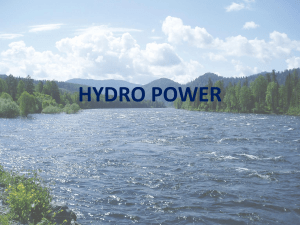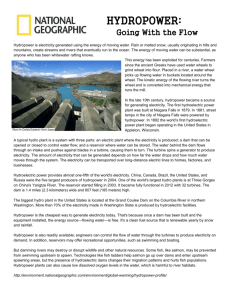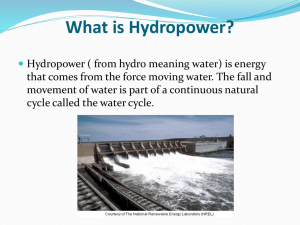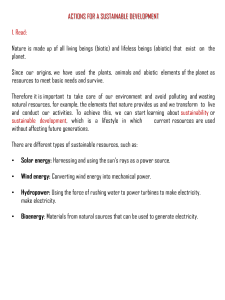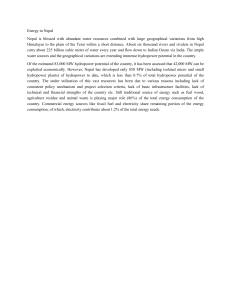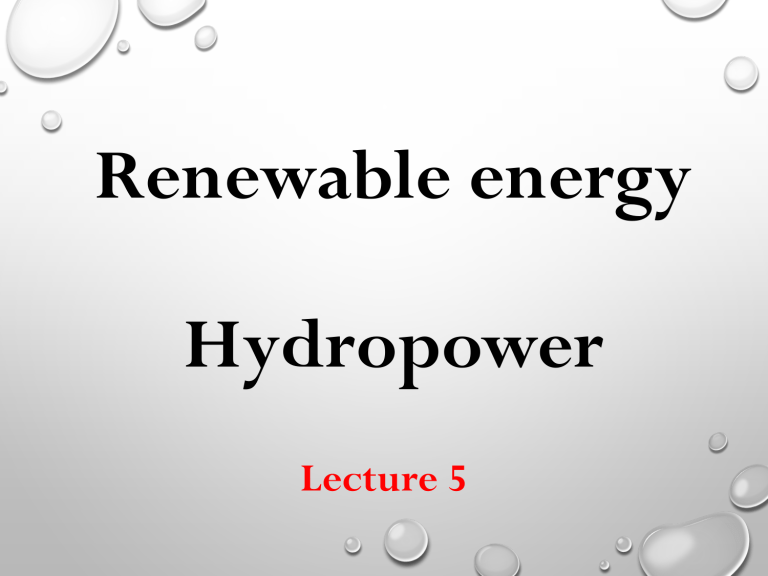
Renewable energy Hydropower Lecture 5 What is hydropower? • Energy from the sun evaporates water in the earth’s oceans and rivers and draws it upward as water vapor. When the water vapor reaches the cooler air in the atmosphere, it condenses and forms clouds. The moisture eventually falls to the earth as rain or snow, replenishing the water in the oceans and rivers. Hydropower plants As people discovered centuries ago, the flow of water represents a huge supply of kinetic energy that can be put to work. Water wheels are useful for generating mechanical energy to grind grains or saw wood, but they are not practical for generating electricity. Water wheels are too bulky and slow. Harnessing water power Selection of site for a hydroelectric power plant: The following factors should be considered while selection the site for hydroelectric power plant 1- availability of water 2- water storage capacity 3- available water head 4- accessibility of the site 5- distance from the load center 6- type of land of site Hydroelectric plants are different. They use modern turbine generators to produce electricity, just as thermal (coal, oil, nuclear power plants do, except that they do not produce heat to spin the turbines. Hydro dam • It’s easier to build a hydro plant where there is a natural waterfall. That’s why the first hydro plant was built at niagara falls. Dams which are artificial waterfalls, are the next best way. • Dams are built on rivers where the terrain will produce an artificial lake or reservoir above the dam. Today there are about 80,000 dams in the united states, but only three percent (2,000) have power generating hydro plants. Classifications of Hydro Power Plants by installed Capacity a)Micro, Installed Capacity: ≥100 kW b)Mini, Installed Capacity: 100-1.000 kW c)Medium ,Installed Capacity: 1.000-10.000 kW (1-10 MW) d)Big, Installed Capacity: >10.000 kW (>10 MW) Classifications of Hydro Power Plants by head a)Low head H < 50 meter b)High Head H > 50 meter High-head Hydropower Tall dams are sometimes referred to as “highhead” hydropower systems. That is, the height from which water falls is relatively high. Low-head Hydropower Many smaller hydropower systems are considered “low-head” because the height from which the water falls is fairly low. Low- head hydropower systems are generally less than 50 meter high. How hydro plant works? • A typical hydro plant is a system with three parts: • - Is power plant where the electricity is produced. • - A dam that can be opened or closed to control water flow. • - A reservoir (artificial lake) where water can be stored. BASIC COMPONENTS 16 Hydropower - 10/18/17 - ©The NEED Project Francis runner Pelton Turbine A Small Pelton Turbine Kaplan Runner • P.E. = Fgravity x H = mass x 9.80 m/Sec2 x H Egp Water ke ke water turbine e electricity • Head is how far the water drops. It is the distance from the highest level of the dammed water to the point where it goes through the power-producing turbine. • Flow is how much water moves through the system-the more water that moves through a system, the higher the flow, generally, a high-bend plant seeds less water flow than a low-bend plant to produce the same amount of electricity, Storing energy One of the biggest advantages of a hydropower plant is its ability to store energy. The water reservoir is after all stored energy. Water can be stored in a reservoir and released when needed for electricity production. During the day when people use more electricity water can flow through a plant to generate electricity. Then during the night when people use less electricity, water can be held back in the reservoir. Storage also makes it possible to save water from winter rains for summer generating power, or to save water from wet years for generating electricity during dry years. Hydropower production How much electricity do we get from hydropower today? Plants produce from five to ten percent of the electricity produced in the Sudan. Today, there are about 78 millions kilowatts of hydro generating capacity in the united states. That’s equivalent to the generating capacity of 80 large nuclear power plants. The biggest hydro plant in the U.S. Is located at the grand coulee dam on the columbia river in northern washington state. The united states also gets some hydropower generated electricity from canada. Some new england utilities buy this imported electricity. What does the future look like for hydropower? The most economical sites for hydropower dams have already been developed so the development of big hydro plants is unlikely. Existing plants could be enlarged to provide additional generating capacity. Plus, many flood-control dams not equipped for electricity production could be retrofitted with generating equipment. The federal energy regulatory commission estimates 30 thousand megawatts of additional generating capacity could be developed in the united states. Advantages • Renewable energy • Clean energy source • Domestic energy source • Generally available as needed • Provides recreational opportunities • Water supply and flood control Possible environmental impacts • Fish population • Quality and flow of water • Ecosystems of rivers and streams Other disadvantages • Drought • Impact on local environment and land use • Preservation concerns
